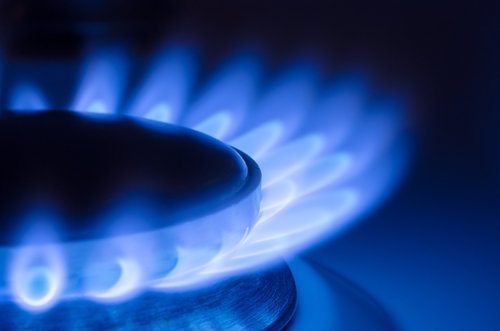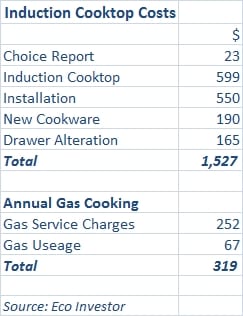

Our family is now off the gas grid. In March we installed an induction cooktop to replace our gas cooktop, which had been our last gas appliance. Everything in our house now runs off electricity including the oven, the solar hot water booster, the lawnmower and the barbeque. The exceptions are the two cars, but I hope to get an electric car next year. When that happens I’ll know enough about our home energy useage to install a suitable solar photovoltaic and battery storage system.
My aim is to save money and reduce our carbon and petrol emissions. That doesn’t mean we’ll go off the electricity grid, and I don’t want to. Our roof doesn’t suit a huge PV system so it would be easier and cost less upfront to get the balance of our energy from a renewable energy supplier, as we do now.
But I had no reservations going off the gas grid. Gas was easier and less costly to replace. It took three steps – choosing an electric oven when we did a major house renovation in 2011, replacing our very old gas hot water heater with electric boosted solar hot water in 2014, and now switching our cooktop from gas to induction.
 Although the gas cooktop was in good working order, both the economic and the environmental advantages of changing were strong and the payback time is reasonable. After we replaced the gas hot water system, our gas useage plummeted and was $67 for the last year, all of it for cooking. $67 would have been OK if that was all we paid, but the additional $252 annual service charge just to be connected to the grid made cooking with gas expensive. Over the past year we also paid $24 in late payment fees, two lots of $12 each, even though payment was only a few days late. This was another reason why our customer loyalty was about zero.
Although the gas cooktop was in good working order, both the economic and the environmental advantages of changing were strong and the payback time is reasonable. After we replaced the gas hot water system, our gas useage plummeted and was $67 for the last year, all of it for cooking. $67 would have been OK if that was all we paid, but the additional $252 annual service charge just to be connected to the grid made cooking with gas expensive. Over the past year we also paid $24 in late payment fees, two lots of $12 each, even though payment was only a few days late. This was another reason why our customer loyalty was about zero.
I researched induction cooking and cooktops and bought a 2014 Choice report for $23 from which I identified 12 models that suited us. In the end, my wife and I narrowed our choice to the cheapest, an IKEA model at $699, and a Westinghouse at $1,261. The IKEA on sale was a newer model to the one in the report but all else looked the same so I assumed it would be close enough if not the same. When we inspected the IKEA and Westinghouse cooktops both looked good. My wife marginally prefered the IKEA. So did I when I got a $100 discount on the price by becoming an IKEA member for free and worked out that the price difference between the IKEA and Westinghouse would pay for the installation.
Installing the cooktop involved turning off the gas, removing the gas cooktop, and putting in a dedicated electric line to the meter box. The electrician who worked on our house renovation gave us what I thought was a very good quote – $495. But as he is good and gives good quotes we had to wait nearly a month to receive the quote and nearly another month to have the cooktop installed. It was worth it. At one point when my patience was low I got another quote – for $1,320. I said no, and fortunately and by coincidence our electrician’s quote came in only a few hours later.
The granite bench top needed a few millimetres shaved off along one edge so that bumped the final price to $550. And a small section of the inside part of the kitchen drawer under the cooktop had to be lowered by a few millimetres so the drawer could clear the bottom part of the cooktop. I was happy to get out my file but my wife wanted the kitchen people to do it. The kitchen man did a good job by lowering the whole inside part of the drawer and that was another $165. We had a couple of fry pans and a pot that work on induction cooktops but we had to spend another $190 on a wok and a couple of saucepans.
All these brought the total cost of the new cooktop to $1,527. Many of the other cooktops cost more than this alone so I am happy with the final cost.
I don’t know what the cooktop will cost to run, but induction cooking is meant to be energy efficient. If, hypothetically, it ends up costing about the same in electricity as we paid for gas – $67 for the last 12 months – that means we save the service charge of $252 per year. That would make the payback period about five and half years, which is fine, and less in practise as the service charge is bound to go up over that time.
Also important is that the induction cooktop is enjoyable to use, and is safer in that it has no flame and shuts down when there is no cookware on the surface.
Going off the gas grid is a key step in our home clean energy strategy. It’s taken a few years to implement, and started with an electric lawn mower. Then lots of roof and wall insulation and an electric oven during our renovation. To better insulate our home I padded our door jambs with seals and put snakes under three of the external doors. In 2013 I bought a gauge and reduced our standby power, and I replaced an old airconditioner with a new energy efficient model. In 2014 I replaced our old gas hot water system with an electric boosted solar hot water system (click here).
I replaced our compact flourescent globes and some old incandescent globes with LEDs (click here).
And I replaced the glass on our back sliding doors and kitchen window with energy efficient Comfortplus glass. We’ve started this year by installing an induction cooktop and going off the gas grid.
But the job is not finished. Some key appliances need to be replaced – a very old fridge, an ailing dishwasher and a temperamental washing machine. But I don’t know when, probably when they break down. Some preliminary research showed we could save about a hundred dollars or more a year in running costs on a modern equivalent to our fridge. So the savings would be useful.
A big step would be trading in my faithful Toyota for an electric city run-around. I can’t afford it yet, but may be able to do so next year. Again, early research shows that about $750 to $1,000 in electricity would replace about $3,000 to $4,000 a year in petrol. There would also be savings in servicing and spare parts. In seven years or so my electric lawnmower hasn’t cost a cent for oil, servicing and spare parts. While a car is not that simple, I read the manual to see what is required to service a Nissan Leaf and it’s peanuts compared to a petrol driven car.
If I get an electric car, at that point all of our home’s energy except for the second car would come from electricity. I think that would be a good time to have a serious look at rooftop solar and by then there should be many battery systems on the market.
Having come this far, I can say that saving money and helping the environment are also interesting and a lot of fun.
Victor Bivell is editor of Eco Investor magazine. See http://www.ecoinvestor.com.au


